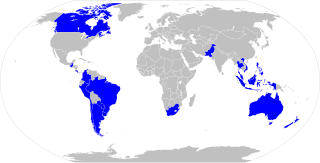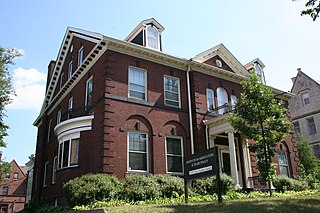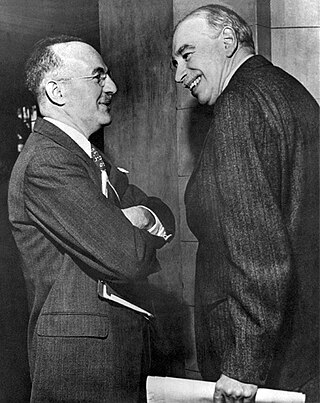The General Agreement on Tariffs and Trade (GATT) is a legal agreement between many countries, whose overall purpose was to promote international trade by reducing or eliminating trade barriers such as tariffs or quotas. According to its preamble, its purpose was the "substantial reduction of tariffs and other trade barriers and the elimination of preferences, on a reciprocal and mutually advantageous basis."

The World Trade Organization (WTO) is an intergovernmental organization headquartered in Geneva, Switzerland that regulates and facilitates international trade. Governments use the organization to establish, revise, and enforce the rules that govern international trade in cooperation with the United Nations System. The WTO is the world's largest international economic organization, with 164 member states representing over 98% of global trade and global GDP.

The Cairns Group is an interest group of 19 agricultural exporting countries, composed of Argentina, Australia, Brazil, Canada, Chile, Colombia, Costa Rica, Guatemala, Indonesia, Malaysia, New Zealand, Pakistan, Paraguay, Peru, the Philippines, South Africa, Thailand, Uruguay, and Vietnam.
The Uruguay Round was the 8th round of multilateral trade negotiations (MTN) conducted within the framework of the General Agreement on Tariffs and Trade (GATT), spanning from 1986 to 1993 and embracing 123 countries as "contracting parties". The Round led to the creation of the World Trade Organization, with GATT remaining as an integral part of the WTO agreements. The broad mandate of the Round had been to extend GATT trade rules to areas previously exempted as too difficult to liberalize and increasingly important new areas previously not included. The Round came into effect in 1995 with deadlines ending in 2000 under the administrative direction of the newly created World Trade Organization (WTO).
The Kennedy Round was the sixth session of General Agreement on Tariffs and Trade (GATT) multilateral trade negotiations held between 1964 and 1967 in Geneva, Switzerland. Congressional passage of the U.S. Trade Expansion Act in 1962 authorized the White House to conduct mutual tariff negotiations, ultimately leading to the Kennedy Round. Participation greatly increased over previous rounds. Sixty-six nations, representing 80% of world trade, attended the official opening on May 4, 1964, at the Palais des Nations. Despite several disagreements over details, the director general announced the round's success on May 15, 1967, and the final agreement was signed on June 30, 1967—the last day permitted under the Trade Expansion Act. The round was named after U.S. President John F. Kennedy, who was assassinated six months before the opening negotiations.

The Doha Development Round or Doha Development Agenda (DDA) is the trade-negotiation round of the World Trade Organization (WTO) which commenced in November 2001 under then director-general Mike Moore. Its objective was to lower trade barriers around the world, and thus facilitate increased global trade.
Olivier Long was a Swiss Ambassador and the director-general of the General Agreement on Tariffs and Trade from 6 May 1968 to 1 October 1980.
The Fourth Ministerial Conference of the World Trade Organization, also known as the WTO Fourth Ministerial Conference, was held at the Sheraton Doha Hotel and Resort, Doha, Qatar from November 9–13, 2001. At this conference, ministers from all WTO members launched the Doha Development Agenda.
The Agreement on Agriculture (AoA) is an international treaty of the World Trade Organization. It was negotiated during the Uruguay Round of the General Agreement on Tariffs and Trade, and entered into force with the establishment of the WTO on January 1, 1995.

The WTO Ministerial Conference of 1999 was a meeting of the World Trade Organization, convened at the Washington State Convention and Trade Center in Seattle, Washington, USA, over the course of three days, beginning Tuesday, 30 November 1999. A week before the meeting, delegates admitted failure to agree on the agenda and the presence of deep disagreements with developing countries. Intended as the launch of a new round of multilateral trade negotiations that would have been called "The Millennium Round", the negotiations were marred by poor organization and controversial management of large street protests. Developing country representatives became resentful and uncooperative on being excluded from talks as the United States and the European Union attempted to cement a mutual deal on agriculture. The negotiations collapsed and were reconvened in Doha, Qatar, in November 2001. The Doha venue enabled on-site public protest to be excluded. Necessary agenda concessions were made to include the interests of developing countries, which had by then further established their own negotiation blocs, such as the Non-Aligned Movement and the Shanghai Co-operation Organisation. Thus, the current round is called the Doha Development Round, which has since 2008 remained stalled as a result of diverging perspectives regarding tariffs, agriculture, and non-tariff barriers such as agricultural subsidies.
This is a timeline of the World Trade Organization (WTO).

Since its creation in 1995, the World Trade Organization (WTO) has worked to maintain and develop international trade. As one of the largest international economic organizations, it has strong influence and control over trading rules and agreements, and thus has the ability to affect a country's economy immensely. The WTO policies aim to balance tariffs and other forms of economic protection with a trade liberalization policy, and to "ensure that trade flows as smoothly, predictably and freely as possible". Indeed, the WTO claims that its actions "cut living costs and raise standards, stimulate economic growth and development, help countries develop, [and] give the weak a stronger voice." Statistically speaking, global trade has consistently grown between one and six percent per annum over the past decade, and US$38.8 billion were allocated to Aid for Trade in 2016.
At the World Trade Organization Ministerial Conference of 2003, trade ministers from 146 members of the World Trade Organization, representing 93 percent of global commerce, convened in Cancún, Mexico, in September 2003. The goal of this meeting was to set a direction for nations among the World Trade Organization to come to agreements and negotiations about agriculture, non agricultural market access, services, and special treatment for developing countries. The negotiations were supposed to be reached by January 1, 2005. Although the agreements had a set date to come to terms, the Cancun Ministerial Conference ended up failing in their mission and did not come to any firm decisions to fix the problem. They failed to make global trade negotiations concrete and founded at that time, so the next steps were uncertain. Although the intentions of this Organization were noble, they were unsuccessful but opportunity was sought after to learn from this failure. Within the committee, there exists a hierarchy within the World Trade Organization. It is made up of trade Administrators that come from all the different sectors of the WTO. The Fifth Ministerial Conference of the World Trade Organization, also known as the WTO Fifth Ministerial Conference and abbreviated as MC5, was held at the Cancún Centro de Convenciones, Cancún, Mexico from September 10 to September 14, 2003.

The Institute for Agriculture and Trade Policy (IATP) is an international non-profit research and advocacy organization that promotes sustainable food, farm, and trade systems. IATP has offices in Minneapolis, Minnesota, Washington, D.C., Geneva, Switzerland and Berlin, Germany.
The term multilateral trade negotiations (MTN) initially applied to negotiations between General Agreement on Tariffs and Trade (GATT) member nations conducted under the auspices of the GATT and aimed at reducing tariff and nontariff trade barriers. In 1995 the World Trade Organization (WTO) replaced the GATT as the administrative body. A current round of multilateral trade negotiations was conducted in the Doha Development Agenda round.

The Global System of Trade Preferences among Developing Countries(G.S.T.P) is a preferential trade agreement, currently encompassing 42 members (“participants”), signed on 13 April 1988 with the aim of increasing trade between developing countries. It was negotiated within the framework of the United Nations Conference on Trade and Development (UNCTAD). The Agreement entered into force on 19 April 1989 and was notified to the then General Agreement on Tariffs and Trade (GATT), predecessor of the World Trade Organization (WTO), on 25 September 1989. The 42 members of GSTP include 7 LDCs as well.
The Bali Package is a trade agreement resulting from the Ninth Ministerial Conference of the World Trade Organization in Bali, Indonesia on 3–7 December 2013. It is aimed at lowering global trade barriers and is the first agreement reached through the WTO that is approved by all its members. The package forms part of the Doha Development Round, which started in 2001.
Afghanistan received membership to the World Trade Organization (WTO) at the 10th WTO Ministerial Conference in Nairobi, Kenya, December 17, 2015. Afghanistan is 164th in the world and 36th among the less-developed countries that have received WTO membership.

The World Trade Organization (WTO) is an intergovernmental organization which regulates international trade. The WTO officially commenced on 1 January 1995 under the Marrakesh Agreement, signed by 123 nations on 15 April 1994, replacing the General Agreement on Tariffs and Trade (GATT), which commenced in 1948. The WTO deals with regulation of trade between participating countries by providing a framework for negotiating trade agreements and a dispute resolution process aimed at enforcing participants' adherence to WTO agreements, which is signed by representatives of member governments and ratified by their parliaments. Most of the issues that the WTO focuses on derive from previous trade negotiations, especially from the Uruguay Round (1986–1994).
The Trade Facilitation Agreement (TFA), was confirmed in Bali, Indonesia in December 2013 at the Ninth Ministerial Conference. After almost 20 years of Negotiations the agreement was officially an open invitation for acceptance from the 160 members of the World Trade Organisation (WTO) on 27 December 2014. However the agreement will only be ratified once 2/3 of the members have informed the WTO of their agreement. For the WTO, the agreement can be viewed as a historic achievement as it is the first multilateral agreement since the WTO's inception in 1995. The Trade Facilitation Agreement of 2014 is a global multilateral initiative to rationalise the stringent procedures which govern international trade. The principal focus of the Agreement is to have numerous positive consequences on developed and Least Developed Countries. Estimates have shown that the Trade Facilitation Agreement would reduce trade costs by an average of 14.5%. In turn, this would prospectively improve trade globally by on trillion dollars. This reduction of bureaucratic 'red tape' will have favourable effects on small to medium Businesses, making it easier for them to trade and join global value chains. One of the most significant aspects of this agreement, lies in the new principle that developing and Least Developed Countries commitments to the implementation of the provisions outlined by the agreement are conditioned on their procurement of necessary technical capacity.







